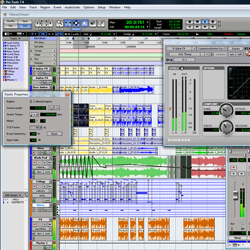
Lead Vocals
Few sessions are as critical to a project as the lead vocal session.
You want the vocalist to be on his game. You want him to be comfortable.
For this reason, it’s a good idea to do multiple takes. I say no more than five. Have the vocalist warm up, then simply record five takes. You can record them to different tracks or different playlists.
What I find is that the singer normally loosens up after a take or two. Usually the last three takes are great, and you’ve got enough to piece together a stellar performance later on.
I’ve done this in many vocal sessions, both when I’m recording another artist, and when I’m recording myself.
It allows you to relax and record. However, it takes a lot of work to go back through all the takes and piece together a good comp.
A Quick Bass Part
Recently I was asked to record bass on a quick 4-hour session. The artist had four hours to track guitars, drums, vocals, bass, and piano for one song. The song also had to be mixed during the 4-hour time slot.
Obviously, we didn’t have the luxury of time on our hands. We recorded everything “analog” style. I practiced one take, then we hit record. I played until I messed up, then we’d stop, hit rewind a bit, and go from there.
Was it a perfect performance? No. But it was still good. Rather than knowing in my head that I had five chances to get it right via multiple takes, I had to make myself focus to nail the part the first time.
If you’re dealing with good musicians, or if you’re short on time, recording with one take like this just might be the ticket.
Obviously, you may not get the very best performance, but I think you’ll be surprised what you come up with. Heck, the Beatles didn’t have Pro Tools, and I think they did okay for themselves.
Loop Recording
Loop recording is another way of doing multiple takes, and I couldn’t finish this article without at least mentioning it. It’s especially helpful if you want to nail down a specific part.
For example, let’s say there’s a 12-bar guitar solo after the second chorus. If your guitarist is like me, he’s not gonna nail it in one take. You can set Pro Tools (or any other DAW) to loop record around those twelve bars.
It’ll basically play back and record the part over and over until you hit stop, and it will keep track of all the takes the guitarist performs. It’s a quick way to get a lot of takes without having to start and stop recording every time.
A word of warning: I’ve gotten lost many a time in the land of loop recording. I’ll think to myself, “Hey, I’ll just do a couple quick takes of this guitar part.” Then I’ll sit there for thirty minutes, trying to come up with a part, then trying to play it perfectly.
It rarely works out, and I end up with a lot of wasted time and a pile of guitar takes that I’ll never use.
Loop recording is good for trying out parts, but it’s better to figure those parts out during pre-production, not when you’re in the middle of a recording session.
Joe Gilder is a Nashville based engineer, musician, and producer who also provides training and advice at the Home Studio Corner.
